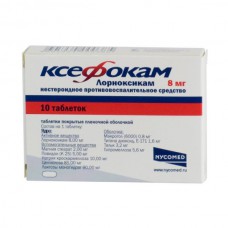Expiration date: 11/2026
The composition and form of issue:
Tablets, film-coated. 1 tablet contains active substance:
lornoxicam 4 mg or 8 mg
excipients: magnesium stearate polyvidone (K25), sodium croscarmellose cellulose lactose monohydrate
shell: macrogol (6000) titanium dioxide E171 talc hypromellose
in blister of aluminium foil and PVC film 10 PCs in carton cartons 1, 2, 3, 5 or 10 blisters.
Description pharmaceutical form:
From white to white with a yellowish sheen color, oblong tablets, film-coated, inscribed with impression "L04" (tablet 4 mg) and "L08" (tablets 8 mg).
Pharmacokinetics:
Lornoxicam is rapidly and almost completely absorbed from the gastrointestinal tract after ingestion. The Cmax in plasma is reached after about 1-2 hours the food Intake reduces Cmax by 30% and increases Tmax to 2.3 h. the Absolute bioavailability of lornoxicam is 90-100%. Lornoxicam is present in plasma mainly in unmodified form, and, to a lesser extent, in the form hydroxylated metabolite which has no pharmacological activity. The binding of lornoxicam with plasma proteins (mainly to albumin fraction) is 99% and does not depend on its concentration.
T1/2, the average is 4 h and is not dependent on the concentration of the drug. Lornoxicam is metabolized completely in the liver. Involved in the metabolism of the CYP2C9 isoenzyme. Approximately 1/3 of the metabolites excreted by the kidney and 2/3 — bile. The elderly and patients with renal or hepatic impairment have not detected significant changes in the pharmacokinetics of lornoxicam.
Description pharmacological action:
Pronounced analgesic and anti-inflammatory effect. Lornoxicam has a complex mechanism of action, which is based on the suppression of PG synthesis due to the inhibition of activity of COX isozymes. In addition, lornoxicam inhibits the release of oxygen free radicals from activated leukocytes.
Analgesic effect of lornoxicam is not associated with narcotic action.
The drug Xefocam aviatophobia has no effect on CNS and, in contrast to narcotic analgesics, not oppressing breathing, does not cause drug dependence.
Dosage:
The risk of ulcerogenic action of the drug allows to reduce the simultaneous administration of proton pump inhibitors and synthetic analogues of prostaglandins. In case of bleeding in the gastrointestinal tract, the drug must immediately stop and take appropriate emergency measures. Especially carefully it is necessary to monitor those patients with gastrointestinal pathology, who first receive treatment with the drug XEFOCAM.
Like other oxicam, the drug XEFOCAM inhibits platelet aggregation and therefore can increase bleeding time. When applying this medication should closely observe the condition of patients in need of a completely normal functioning of the coagulation system (eg, patients who have surgical intervention), with disorders of blood coagulation system or receiving medications that inhibit clotting (including heparin in low doses), in order to timely detect signs of bleeding.
If signs of liver damage (itching, yellowing of the skin, nausea, vomiting, abdominal pain, dark urine, increased levels of "liver" transaminases) should stop taking the drug and contact your doctor.
You should not use this medication simultaneously with other NSAIDs.
The drug can change the properties of platelets, but does not replace the preventive effect of acetylsalicylic acid in cardiovascular diseases.
Patients with impaired kidney function, caused by large blood loss or severe dehydration, XEFOCAM, as an inhibitor of prostaglandin synthesis, can be assigned only after the elimination of hypovolemia and associated with it the danger of reducing perfusion of the kidneys. Like other NSAIDs, XEFOCAM can cause a rise in blood concentration of urea and creatinine, and also water retention and
sodium, peripheral edema, arterial hypertension and other early signs of nephropathy. Long-term treatment of such patients with the drug XEFOCAM may cause the following effects: glomerulonephritis, papillary necrosis and nephrotic syndrome with transition to acute renal failure. Patients with severe reduction in kidney function, the drug XEFOCAM can not be assigned (see "Contraindications"). In elderly patients and in patients suffering from arterial hypertension and/or obesity, it is necessary to control blood pressure.
It is especially important to monitor renal function in elderly patients and in patients:
- concurrently receiving diuretics
- concurrently receiving medications that can cause of kidney damage.
Long-term use of the drug XEFOCAM is necessary to periodically monitor hematologic parameters and renal function and liver. The use of the drug can negatively affect female fertility and is not recommended for women planning pregnancy.
Patients who use the drug, you must abstain from types of action that require greater attention, rapid mental and motor reactions, alcohol consumption.
Release form
Tablets film-coated 4 mg and 8 mg.
10 tablets are in blister aluminum foil and PVC film. 1, 2, 3, 5 or 10 blisters with the instruction on application place in a cardboard box.
Shelf life
5 years. Do not use the drug after the expiration date. Storage conditions
List B. the temperature is not above 25° C. Keep out of reach of children.
Indications:
- short-term treatment of pain syndrome of various origin
- symptomatic therapy of rheumatic diseases (rheumatoid arthritis, osteoarthritis, ankylosing spondylitis, articular syndrome with exacerbation of gout, rheumatic soft tissue).
Contraindications:
- known hypersensitivity/Allergy to lornoxicam or to any of the ingredients of the drug
- full or partial combination of bronchial asthma, recurrent polyposis of the nose or paranasal sinuses and intolerance of acetylsalicylic acid and other NSAIDs (including history)
- hemorrhagic diathesis or coagulation defects, and patients undergoing surgery associated with a risk of bleeding or incomplete hemostasis
- since the coronary artery bypass surgery
- erosive-ulcerative changes of the gastric mucosa or duodenal ulcers, active gastrointestinal bleeding
- cerebrovascular or other bleeding
- recurrent gastric ulcer or recurrent gastrointestinal bleeding
- gastrointestinal bleeding associated with NSAIDs in history
- inflammatory bowel disease (Crohn's disease, ulcerative colitis) in the acute phase
- decompensated heart failure
- severe hepatic impairment or active liver disease
- renal insufficiency (serum creatinine more than 300 µmol/l), progressive renal disease
- confirmed hyperkalemia, hypovolemia or dehydration
- pregnancy and breastfeeding
- children up to age 18 years (due to the lack of clinical data on its use in this age group).
Caution: erosivno-azwenne defeat and bleeding from the gastrointestinal tract (history) moderate renal insufficiency status after surgery age over 65 years coronary artery disease, congestive heart failure (CHF) cerebrovascular disease dyslipidemia/hyperlipidemia diabetes mellitus peripheral arterial disease Smoking creatinine clearance less than 60 ml/min ulcerative lesions of the gastrointestinal tract in the anamnesis the presence of Helicobacter pylori infection long-term use of NSAIDs alcoholism severe somatic diseases concomitant use of oral corticosteroids (including prednisone), anticoagulants (including warfarin), antiplatelet agents (including clopidogrel), SSRIs (including citalopram, fluoxetine, paroxetine, sertraline).
Side effects:
From the gastrointestinal tract and liver: dyspepsia, abdominal pain, dry mouth, stomatitis, nausea, vomiting, heartburn, diarrhea, esophagitis, gastritis, erosive and ulcerative lesions of the mucous membrane of the stomach and intestines, including perforation and bleeding, constipation, flatulence, melena, abnormal liver function, elevated liver transaminases.
From the nervous system: headache, dizziness, drowsiness, sleep disturbances, depression, agitation, tremor, aseptic meningitis, paresthesia.
On the part of the skin and subcutaneous fat: otechny syndrome, ekhimozy, skin rash, pruritus, urticaria, alopecia, Stevens-Johnson syndrome, Lyell's syndrome, angioedema.
From the urinary system: dysuria, reduced glomerular filtration, interstitial nephritis, glomerulonephritis, papillary necrosis, nephrotic syndrome, peripheral edema, acute renal failure.
From the sensory organs: tinnitus, blurred vision.
From the CCC: development or exacerbation of cardiac insufficiency, tachycardia, increased blood pressure.
Organs of hematopoiesis and hemostasis system: agranulocytosis, leukopenia, anemia, thrombocytopenia, increased bleeding time.
On the part of the respiratory system: pharyngitis, rhinitis, dyspnoea, cough, bronchospasm.
Other: anorexia, increased sweating, weight changes, arthralgia, myalgia.
Drug interactions:
While the use of the drug Xefocam and cimetidine — increase the concentration of lornoxicam in plasma ranitidine and antacids — interactions have been identified anticoagulants or thrombocyte aggregation inhibitors — may increase bleeding time (increased risk of bleeding, it is necessary to control MHO) beta-blockers and ACE inhibitors — may reduce antihypertensive effect of diuretics — reduced diuretic effect and a hypotensive effect digoxin — reduced renal clearance of digoxin of quinoline antibiotics increase the risk of seizures other NSAIDs or corticosteroids — increased risk of gastrointestinal bleeding methotrexate — increasing the concentration of methotrexate in serum SSRI (e.g. citalopram, fluoxetine, paroxetine, sertraline) — increase the risk of bleeding from the digestive tract lithium salts — may increase peak concentrations of lithium in the plasma and, thereby, strengthening the known side effects of lithium cyclosporine — increased cyclosporine nephrotoxicity of sulfonylureas — increase hypoglycemic effect of alcohol, corticotropin, potassium — increase the risk of side effects from the gastrointestinal tract cefamandole, cefoperazone, cefotetan, valproic acid — increased risk of bleeding.
Method of application and dose:
Inside, before meals, with a glass of water.
When expressed pain syndrome: the recommended dose is 8-16 mg/day, divided into 2-3 doses with a maximum daily dose 16 mg.
In inflammatory and degenerative rheumatic diseases: the recommended initial dose of 12 mg standard dose 8-16 mg/day, depending on the condition of the patient.
The duration of therapy depends on the nature and course of the disease.
In diseases of the gastrointestinal tract, patients with impaired renal function or liver disease, the elderly (over 65 years), after extensive operations it is recommended that the maximum daily dose is 12 mg divided during the day into 3 doses at 4 mg.
To reduce the risk of adverse effects from the blood should use the minimum effective dose minimum possible short course.
Overdose:
Symptoms: may increase the above-described side effects of Xefocam.
Treatment: symptomatic. Administration of activated charcoal immediately after receiving Xefocam® can reduce the absorption of this drug. To prevent damage to the mucosa of the gastrointestinal tract may prescription anti-ulcer drugs. Dialysis is ineffective.
Special instructions:
The risk of ulcerogenic action of the drug allows to reduce the simultaneous administration of proton pump inhibitors and synthetic analogues of PG. In case of bleeding in the gastrointestinal tract, the drug must immediately stop and take appropriate emergency measures. Especially carefully it is necessary to monitor those patients with gastrointestinal pathology, who first receive treatment with the drug Xefocam.
Like other oxicam, inhibits platelet aggregation and therefore can increase bleeding time. When applying this medication should closely observe the condition of patients in need of a completely normal functioning of blood coagulation system (for example, patients who have surgical intervention), with disorders of blood coagulation system or receiving drugs that inhibit clotting (including heparin in low doses), in order to timely detect signs of bleeding.
If signs of liver damage (itching, yellowing of the skin, nausea, vomiting, abdominal pain, dark urine, elevated liver transaminases) should stop taking the drug and contact your doctor.
You should not use this medication simultaneously with other NSAIDs.
The drug can change the properties of platelets, but does not replace the preventive effect of acetylsalicylic acid in cardiovascular diseases.
Patients with impaired kidney function, caused by large blood loss or severe dehydration, the drug Xefocam, as an inhibitor of the synthesis of GHG, can be assigned only after the elimination of hypovolemia and associated with it the danger of reducing perfusion of the kidneys. Like other NSAIDs, may cause an increase in blood concentration of urea and creatinine, and also water retention and sodium, peripheral edema, arterial hypertension and other early signs of nephropathy. Long-term treatment of such patients with the drug Xefocam may cause the following effects: glomerulonephritis, papillary necrosis and nephrotic syndrome with transition to acute renal failure. Patients with severe reduction in kidney function, the drug can not be assigned (see "Contraindications"). In elderly patients and in patients suffering from arterial hypertension and/or obesity, it is necessary to control blood pressure.
It is especially important to monitor renal function in elderly patients and in patients simultaneously receiving diuretics and drugs that can cause kidney damage.
Long-term use of the drug Xefocam is necessary to periodically monitor hematologic parameters and renal function and liver. The use of the drug can negatively affect female fertility and is not recommended for women planning pregnancy.
Patients who use the drug, you must abstain from types of action that require greater attention, rapid mental and motor reactions, alcohol consumption.



